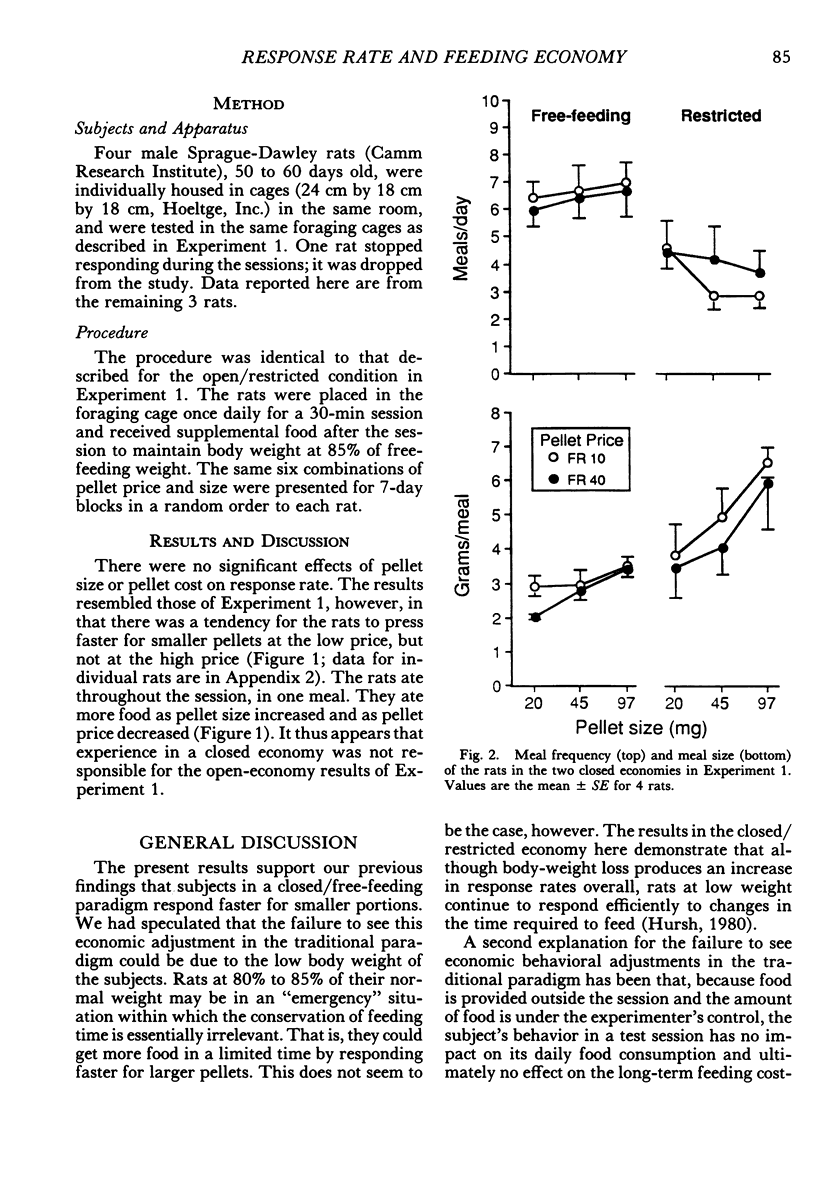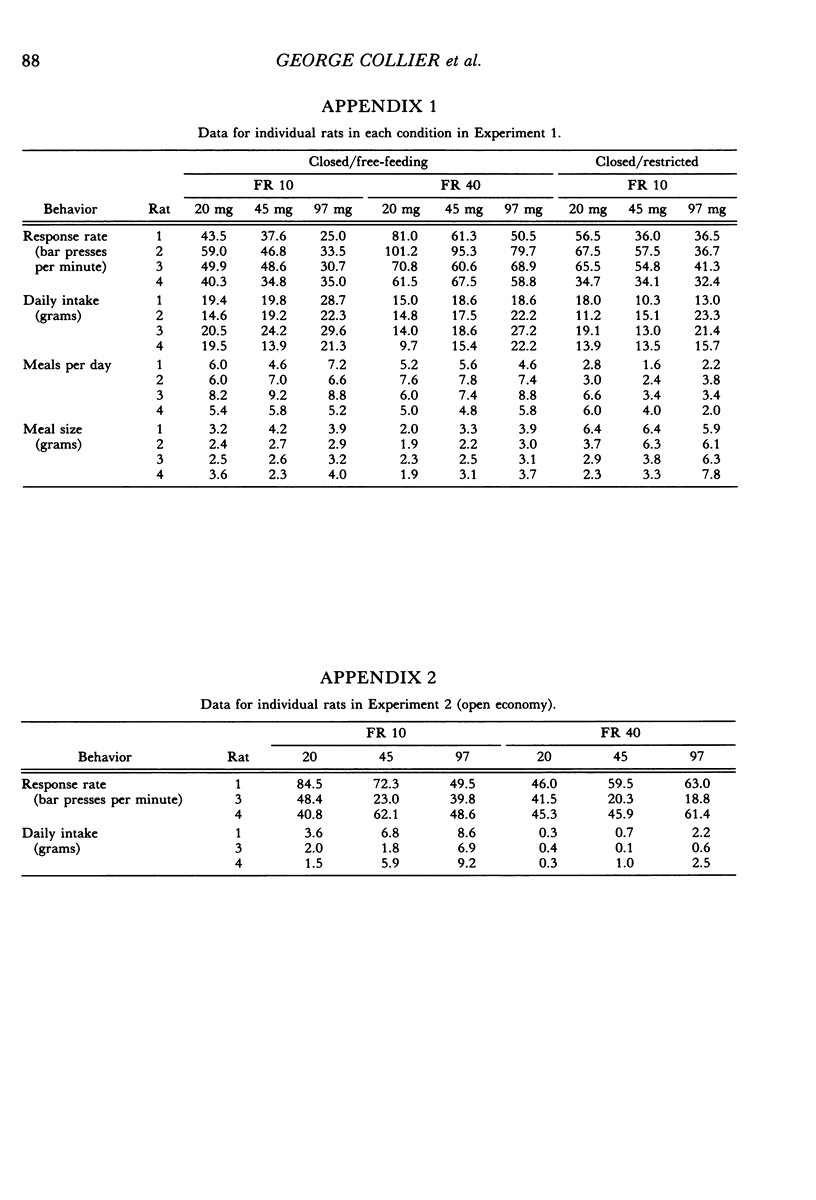Abstract
It has been hypothesized that the magnitude-of-reinforcement effect may differ in closed and open experimental economies. We determined the relationship between magnitude of reinforcement and response rate in three feeding conditions: a closed economy in which total intake was unrestricted, a closed economy in which total intake was restricted so as to maintain body weight at 85% of free-feeding weight, and a traditional open economy in which subjects received food outside the experimental session. In the closed economies, regardless of body weight, the rats responded faster for smaller pellets and when the fixed ratio for pellets was higher. In the open economy, there was no reliable effect of pellet size or pellet cost on response rate. It is concluded that although there are circumstances in which response rate is an immediate function of the parameters of reinforcement, rate is not necessarily a measure of response strength. Response rate may instead, or additionally, contribute to a strategy of reducing the costs associated with resource utilization.
Full text
PDF








Selected References
These references are in PubMed. This may not be the complete list of references from this article.
- Bonem M., Crossman E. K. Elucidating the effects of reinforcement magnitude. Psychol Bull. 1988 Nov;104(3):348–362. doi: 10.1037/0033-2909.104.3.348. [DOI] [PubMed] [Google Scholar]
- CATANIA A. C. Concurrent performances: a baseline for the study of reinforcement magnitude. J Exp Anal Behav. 1963 Apr;6:299–300. doi: 10.1901/jeab.1963.6-299. [DOI] [PMC free article] [PubMed] [Google Scholar]
- COLLIER G., MYERS L. The loci of reinforcement. J Exp Psychol. 1961 Jan;61:57–66. doi: 10.1037/h0048851. [DOI] [PubMed] [Google Scholar]
- COLLIER G. Some properties of saccharin as a reinforcer. J Exp Psychol. 1962 Aug;64:184–191. doi: 10.1037/h0048795. [DOI] [PubMed] [Google Scholar]
- COLLIER G., WILLIS F. N. Deprivation and reinforcement. J Exp Psychol. 1961 Oct;62:377–384. doi: 10.1037/h0047144. [DOI] [PubMed] [Google Scholar]
- Collier G. H., Johnson D. F., Hill W. L., Kaufman L. W. The economics of the law of effect. J Exp Anal Behav. 1986 Sep;46(2):113–136. doi: 10.1901/jeab.1986.46-113. [DOI] [PMC free article] [PubMed] [Google Scholar]
- Collier G., Bolles R. Hunger, thirst, and their interaction as determinants of sucrose consumption. J Comp Physiol Psychol. 1968 Dec;66(3):633–641. doi: 10.1037/h0026538. [DOI] [PubMed] [Google Scholar]
- GUTTMAN N. Operant conditioning, extinction, and periodic reinforcement in relation to concentration of sucrose used as reinforcing agent. J Exp Psychol. 1953 Oct;46(4):213–224. doi: 10.1037/h0061893. [DOI] [PubMed] [Google Scholar]
- HUTT P. J. Rate of bar pressing as a function of quality and quantity of food reward. J Comp Physiol Psychol. 1954 Jun;47(3):235–239. doi: 10.1037/h0059855. [DOI] [PubMed] [Google Scholar]
- Hirsch E., Collier G. Effort as determinant of intake and patterns of drinking in the guinea pig. Physiol Behav. 1974 Apr;12(4):647–655. doi: 10.1016/0031-9384(74)90215-7. [DOI] [PubMed] [Google Scholar]
- Hursh S. R. Economic concepts for the analysis of behavior. J Exp Anal Behav. 1980 Sep;34(2):219–238. doi: 10.1901/jeab.1980.34-219. [DOI] [PMC free article] [PubMed] [Google Scholar]
- Johnson D. F., Ackroff K., Peters J., Collier G. H. Changes in rats' meal patterns as a function of the caloric density of the diet. Physiol Behav. 1986;36(5):929–936. doi: 10.1016/0031-9384(86)90455-5. [DOI] [PubMed] [Google Scholar]
- Johnson D. F., Collier G. H. Caloric regulation and patterns of food choice in a patchy environment: the value and cost of alternative foods. Physiol Behav. 1987;39(3):351–359. doi: 10.1016/0031-9384(87)90234-4. [DOI] [PubMed] [Google Scholar]
- Nevin J. A., Mandell C., Atak J. R. The analysis of behavioral momentum. J Exp Anal Behav. 1983 Jan;39(1):49–59. doi: 10.1901/jeab.1983.39-49. [DOI] [PMC free article] [PubMed] [Google Scholar]
- PUBOLS B. H., Jr Incentive magnitude, learning and performance in animals. Psychol Bull. 1960 Mar;57:89–115. doi: 10.1037/h0042065. [DOI] [PubMed] [Google Scholar]
- Reed P., Wright J. E. Effects of magnitude of food reinforcement on free-operant response rates. J Exp Anal Behav. 1988 Jan;49(1):75–85. doi: 10.1901/jeab.1988.49-75. [DOI] [PMC free article] [PubMed] [Google Scholar]
- Timberlake W. A temporal limit on the effect of future food on current performance in an analogue of foraging and welfare. J Exp Anal Behav. 1984 Mar;41(2):117–124. doi: 10.1901/jeab.1984.41-117. [DOI] [PMC free article] [PubMed] [Google Scholar]
- Timberlake W., Gawley D. J., Lucas G. A. Time horizons in rats foraging for food in temporally separated patches. J Exp Psychol Anim Behav Process. 1987 Jul;13(3):302–309. [PubMed] [Google Scholar]


